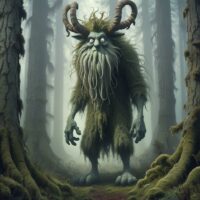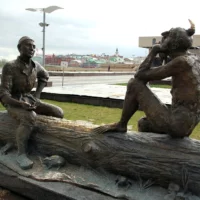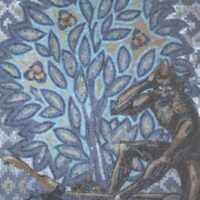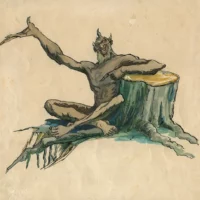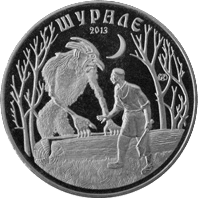Shurali : The Forest Spirit
Listen
At a glance
| Description | |
|---|---|
| Origin | Turkic Mythology |
| Classification | Spirits |
| Family Members | N/A |
| Region | Russia |
| Associated With | Forests, Mischief |
Shurali
Introduction
In the deep forests of the Volga and Ural regions, stories circulate about a strange creature that embodies both fear and fascination. This being is Shurali, a legendary forest spirit in Tatar and Bashkir mythology. Known for his mischievous tricks and terrifying powers, Shurali represents humanity’s long-standing relationship with the natural world. Far from being a forgotten relic of the past, Shurali continues to capture the imagination of storytellers, artists, and even modern communities, symbolizing the wildness of forests and the mystery of unseen spirits. What makes him unique is not only his frightening abilities but also his cultural significance, bridging ancient shamanic beliefs with contemporary folklore.
Physical Traits
Descriptions of Shurali vary across regions, but his most consistent traits make him instantly recognizable in stories. He is usually imagined as a tall, humanoid creature with an animal-like appearance, covered from head to toe in thick fur. A single horn juts out from his forehead, giving him a demonic or otherworldly quality. His most unsettling feature is his long, spindly fingers, which he uses not only for tricks but also to torment victims. Some depictions go further, portraying Shurali with one large eye, combining both monstrous and comic elements. When he disguises himself as a human, he is betrayed by one clue—he wears his shoes backward, a classic marker of supernatural beings in Turkic folklore.
These physical traits are more than grotesque details; they serve symbolic purposes. His horn signals danger and untamed power, his fur ties him to the wilderness, and his elongated fingers emphasize his role as a manipulator of humans. Together, they create a terrifying yet unforgettable image that has allowed Shurali to remain a central figure in folklore for centuries.
Family
Unlike many spirits who exist in complete isolation, Shurali sometimes appears in myths as part of a larger community. In certain Bashkir traditions, he is said to have wives and children who live with him in the forest. Folktales even suggest that some human families descended from unions between Shurali’s kin and villagers, giving him a role as a mystical ancestor. One such Bashkir clan, known as the “shaitan-kudei,” claimed lineage connected to these forest beings.
Even when family ties are not explicitly mentioned, Shurali’s connections to similar figures across Turkic and Finno-Ugric traditions create a broader sense of kinship. Characters such as the Chuvash Arçuri, the Siberian Tatar Pitsen, and the Ural Tatar Yarımtıq share traits with Shurali, suggesting that they are variations of a single mythological archetype. This interconnectedness reinforces the idea that Shurali is not an isolated figure but part of a pan-regional network of spirits born out of humanity’s shared relationship with forests.
Other names
The name Shurali itself appears in multiple forms depending on the cultural context. Among Tatars and Bashkirs, it is commonly written as Şüräle or Shurale, while Turkish sources sometimes use the spelling Şürele. The word is linguistically linked to “shura,” combined with the Turkic suffix “-le,” marking it as a being connected to the forest.
What is fascinating is that the concept of Shurali is mirrored in other traditions under different names. The Chuvash Arçuri, the Udmurt leshy-like spirits, and the Mari woodland figures all share overlapping characteristics. Even the old Chuvash word “shurale” once meant “a person possessed by a half-demon,” which over time was reinterpreted by Tatars to mean an exclusively forest-dwelling spirit. This linguistic evolution highlights how myths adapt to cultural shifts, ensuring Shurali’s name and essence remain alive across multiple societies.
Powers and Abilities
The stories surrounding Shurali emphasize his unusual and often deadly powers. His most notorious ability is his lethal sense of humor—he lures travelers into thickets and tickles them until they die of exhaustion. This darkly comic trait distinguishes him from other spirits, blending terror with absurdity. Shurali is also a shapeshifter, capable of appearing as a peasant or even as a woman to deceive passersby. In human form, his glowing eyes and backward shoes give away his true identity.
He delights in misleading woodcutters, hiding their axes, or causing peasants to lose their way in the forest. Horses, too, are not safe, as Shurali is said to mount them and ride them into exhaustion overnight. For those who manage to befriend him, however, he may reveal secrets of the magical arts, showing that his powers can both harm and empower.
Folklore also provides ways to escape his tricks. Turning one’s clothes inside out and reversing shoes is a common protective tactic, as it confuses the spirit. Religious invocations such as reciting “Bismillah” are believed to drive him away, reflecting the blending of Islamic practices with pre-Islamic beliefs. Some tales even suggest that inserting a stick into the hole under his armpit can weaken or immobilize him, giving mortals a chance to flee. These stories highlight not only his dangerous nature but also the resourcefulness of humans in surviving encounters with him.
Modern Day Influence
Despite the passing of centuries, Shurali remains a vivid presence in modern culture. His most famous literary appearance is in the poem by Tatar writer Ğabdulla Tuqay, published in 1907. Tuqay’s work immortalized Shurali in the minds of generations, turning him into both a subject of humor and a symbol of cultural identity. Tuqay even used Şüräle as a pseudonym, further binding the poet’s legacy to the forest spirit. Later, in 1909, he cautioned readers not to take such spirits too seriously, showing how folklore can be reshaped to suit changing times.
In performing arts, Shurali inspired the very first Tatar ballet, composed by Farit Yarullin, which remains a cornerstone of Tatar cultural history. More recently, Shurali has appeared in music, such as Adeliia Faizullina’s Tatar Folk Tales (2018), whose opening movement depicts him as a haunting presence in the forest.
Shurali has also been brought to life through animation and film. From the 1987 Soyuzmultfilm adaptation, which gave a psychological twist to the story, to Tatarmultfilm’s 2014 retelling and ShayanTV’s claymation series in 2020, each version reflects how Shurali can shift between menacing and comical roles depending on audience and context. These reinterpretations demonstrate his adaptability, ensuring his relevance across different generations.
Beyond art and media, Shurali holds symbolic power in contemporary society. In post-Soviet Tatarstan, some neopagan groups have revived belief in spirits like Shurali as part of reconnecting with nature. Teachers also use stories of Shurali in schools to teach ecological awareness, presenting him as a reminder of humanity’s dependence on forests. Even Tatar youth suggest dressing as Shurali for Halloween, blending folklore with modern global traditions. Religious leaders, too, reinterpret him through the lens of Islamic theology, categorizing him among the Qur’anic jinn. In all these ways, Shurali continues to evolve, not as a relic of the past, but as a dynamic cultural figure shaping identity and imagination.
Related Images
Source
Beydili, C. (2003). Türk Mitolojisi Ansiklopedik Sözlük. Yurt Yayınevi. (p. 531)
Zaripova, Ç. (n.d.). Mitolojik Varlıklar. Kazan: Tatar Türklerinde Varlıklar.
Tuqay, Ğ. (1907). Şüräle. Kazan. [Poem referenced in ballet and modern adaptations]
Sulteev, R. (n.d.). Arçura/Şüräle: Mythical Spirits of the Volga-Ural Forests.
Wikipedia contributors. (n.d.). Şüräle. Wikipedia. Retrieved September 17, 2025, from https://en.wikipedia.org/wiki/%C5%9E%C3%BCr%C3%A4le
u/Archaic_Archivist. (2021, March 15). Shurale: Anthropomorphic mythical creature of Tatar folklore [Online forum post]. Reddit. Retrieved September 17, 2025, from https://www.reddit.com/r/mythology/comments/m6167e/shurale_anthropomorphic_mythical_creature_of/
Sulteev, R. (2020). Arçura/Şüräle: Mythical spirits of the Volga-Ural forests. Academia.edu. Retrieved September 17, 2025, from https://www.academia.edu/47092536/Ar%C3%A7ura_%C5%9E%C3%BCr%C3%A4le_Mythical_Spirits_of_the_Volga_Ural_Forests
Frequently Asked Questions
What is lorem Ipsum?
I am text block. Click edit button to change this text. Lorem ipsum dolor sit amet, consectetur adipiscing elit. Ut elit tellus, luctus nec ullamcorper mattis, pulvinar dapibus leo.
What is lorem Ipsum?
I am text block. Click edit button to change this text. Lorem ipsum dolor sit amet, consectetur adipiscing elit. Ut elit tellus, luctus nec ullamcorper mattis, pulvinar dapibus leo.
What is lorem Ipsum?
I am text block. Click edit button to change this text. Lorem ipsum dolor sit amet, consectetur adipiscing elit. Ut elit tellus, luctus nec ullamcorper mattis, pulvinar dapibus leo.
What is lorem Ipsum?
I am text block. Click edit button to change this text. Lorem ipsum dolor sit amet, consectetur adipiscing elit. Ut elit tellus, luctus nec ullamcorper mattis, pulvinar dapibus leo.
What is lorem Ipsum?
I am text block. Click edit button to change this text. Lorem ipsum dolor sit amet, consectetur adipiscing elit. Ut elit tellus, luctus nec ullamcorper mattis, pulvinar dapibus leo.


